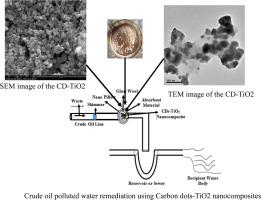Carbon dots-titanium oxide nanocomposite for effective treatment of crude oil-contaminated water
IF 7.7
Q2 ENGINEERING, ENVIRONMENTAL
引用次数: 0
Abstract
This study examined the synthesis, characterization, and application of carbon dots-titanium oxide (CDs-TiO₂) nanocomposite for the treatment of crude oil-contaminated water. CDs were obtained from sawdust using a hydrothermal method, while TiO₂ nanoparticles were synthesized via a green approach using avocado leaf extract and titanium tetraisopropoxide. The nanocomposite was formed by mixing CDs and TiO₂ nanoparticles in a 1:1 ratio. The synthesized materials were characterized using UV–Vis spectrophotometry, X-ray diffraction (XRD), scanning electron microscopy (SEM), transmission electron microscopy (TEM), energy-dispersive X-ray spectroscopy (EDX), and Fourier-transform infrared spectroscopy (FTIR). Characterization results confirmed the successful integration of CDs and TiO₂ nanoparticles in the composite. They all displayed spherical shape nanostructures with particle sizes of 6,8 nm, 11.25 and 10.8 nm for CDs, TiONPs and the CD-TiONPs composites respectively. The synthesized CDs, TiO₂ NPs, and the nanocomposite were each applied for the treatment of crude oil contaminated water. The nanocomposite exhibited enhanced capacity for crude oil removal compared to either of its components. The nanocomposite exhibited high efficiency in removing crude oil from contaminated water, with a removal efficiency of up to 83 %.

碳点-氧化钛纳米复合材料有效处理原油污染水
研究了碳点-氧化钛(CDs-TiO 2)纳米复合材料的合成、表征及其在原油污染水处理中的应用。采用水热法从木屑中提取CDs,采用绿色法以牛油果叶提取物和四异丙醇钛为原料合成tio2纳米颗粒。该纳米复合材料是由CDs和tio2纳米颗粒以1:1的比例混合而成。采用紫外可见分光光度法、x射线衍射仪(XRD)、扫描电镜(SEM)、透射电镜(TEM)、能量色散x射线能谱仪(EDX)和傅里叶变换红外光谱(FTIR)对合成材料进行了表征。表征结果证实了CDs和tio2纳米颗粒在复合材料中的成功整合。CDs、TiONPs和CD-TiONPs复合材料均呈现球形纳米结构,粒径分别为6、8、11.25和10.8 nm。将合成的CDs、tio2 NPs和纳米复合材料分别应用于原油污染水的处理。与任何一种组分相比,纳米复合材料表现出更强的原油去除能力。该纳米复合材料对污染水中原油的去除率高达83%。
本文章由计算机程序翻译,如有差异,请以英文原文为准。
求助全文
约1分钟内获得全文
求助全文
来源期刊

Journal of hazardous materials advances
Environmental Engineering
CiteScore
4.80
自引率
0.00%
发文量
0
审稿时长
50 days
 求助内容:
求助内容: 应助结果提醒方式:
应助结果提醒方式:


